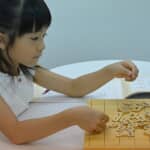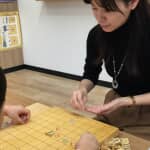26 August 2019
Things That Shogi Beginner Children Often Get Confused with: #7 Tend to Miss a Chance in Checking
*Please note that the Kanji numbers in pictures are spelled in English in the text. The following Shogi boards have a face with files (vertical rows) numbered 1 through 9, from right to left, and ranks (horizontal rows) designated with Kanji characters, “一” (One) to “九” (Nine), from top to bottom. On the other hand, in the text, each Kanji character is replaced with an alphabet, from “a” to “i” : “一” with “a”, “二” with “b”, … and “九” with ”i”.
The More You Chase, the More Gyoku (King) Runs Away.
You will win a game by capturing your opponent’s Gyoku (King). Knowing that, many Shogi beginners are often excited to check. Check is a move to threaten to capture your opponent’s Gyoku (King) on the next move. Once they find the situation in which they can check, they do willingly saying aloud, “Check!”. By the way, you need not say aloud, “Check”, as you know.
What is Check?
When you are giving check to your opponent, what he/she will do? He/She will never wait for being captured. He/She will move Gyoku (King) against checking or other pieces to protect his/her Gyoku (King). What if you give check again? Gyoku (King) will keep running away to find a wider space or the number of pieces to protect Gyoku (King) will be increased. It will be hard for you to attack Gyoku (King).
Shogi beginners, in particular, are more likely to miss a chance to capture Gyoku (King) and to give a chance for an opponent to reinforce his/her defense. That is because Shogi beginners often keep giving check from the same direction. Remember what you do in fishing or in catching insects. If you chase them from one direction, they will keep running away in the opposite direction, won’t they?
The picture below shows the situation in which you are giving check, ▲+R-2a.
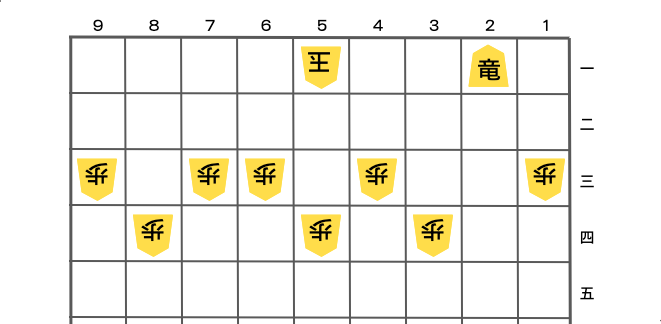
I would say it’s not an effective attack. This attack will cause Gyoku (King), which is placed on the first rank, to move to the second rank.
Giving check repeatedly allows Gyoku (King) to run away. There is a Shogi proverb to warn against that: Oute wa ou te, which means checking is a move to chase Gyoku (King). It alerts you to the negative results by repeating checks.
You may well wonder how to capture Gyoku (King). You win a game by checkmating after checking. That is true, but the point here is that unnecessary check won’t work.
Not to “Capture” Gyoku (King), But to Not It Run Away
Point 1: Chace Gyoku (King) to the Narrow Space.
Gyoku (King) moves one square at a time, which tells it moves slowly. Even so, because it can move to any directions, it has many squares to run away.
What you need to do to capture Goku (King) more easily is to reduce the number of squares to which it can run away. To reduce that, chase Goku (King) to the lower ranks or the corners in particular. The lower ranks are the ones from your opponent’s side.
In the picture below, there are three pieces of Goku (King). Two pieces of them are on the lowest rank; one is on the top right corner and the other is on the seventh file.
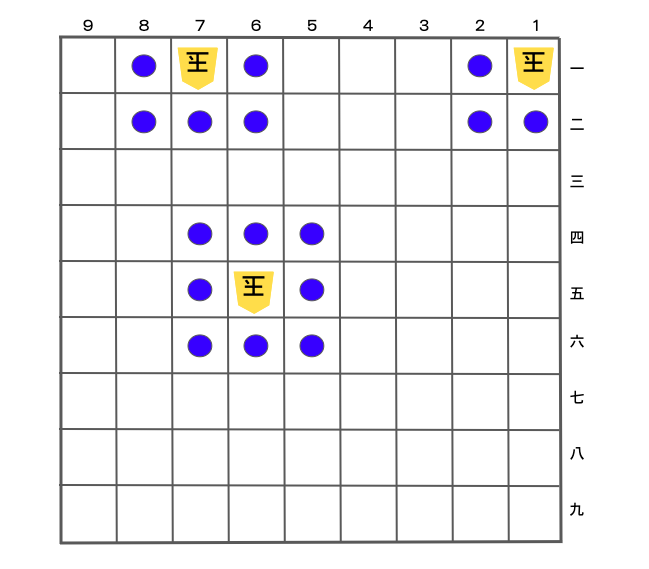
Blue circles show squares to which Goku (King) can move. Count and compare them of each Goku (King): three circles for one on the top right corner, five for another on the top left, and eight for the other around the center. As you saw, Goku (King) on the lower rank has fewer squares to move to.
There is one thing you should be careful about. That is not to chase Goku (King) to the upper rank, the upper which is from your opponent’s side. Chasing Goku (King) to the upper rank will reduce squares to which it can move to. However, you will lose chances to use your own pieces to attack. Shogi pieces mainly move forward, not backward and are not good at attacking pieces behind themselves.
Look at the below picture. Blue circles are showing squares to which Goku (King) can move. The number of squares is the same, five, as that of one placed on the lowest rank. Meanwhile, because your pieces of Kei (Knight), Kyo (Lance), and Fu (Pawn) move only forward, not backward, you can’t use them to attack this Goku (King).
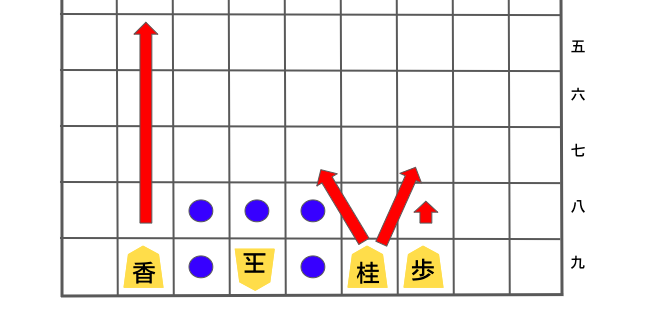
Besides that, your Goku (King) will be at risk by allowing your opponent’s Goku (King) to approach your camp. Pieces dropped to protect your opponent’s Goku (King) could attack your Goku (King).
Point 2: Have Pieces Waiting for Goku (King).
Try to keep your opponent’s Goku (King) from moving toward the upper ranks. To do so, have pieces waiting for Goku (King), which is termed Machigoma in Japanese. Waiting pieces are pieces who don’t give check but wait for your opponent’s Goku (King) coming. Kin (Gold) or Gin (Silver), which moves similarly as Goku (King), are suitable for being waiting pieces.
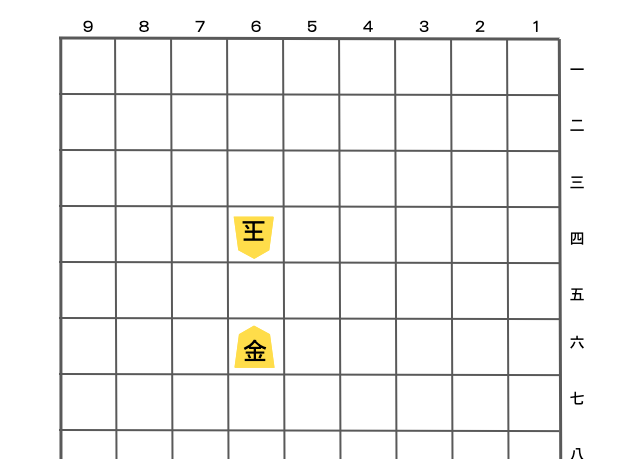
Goku (King) shown in the above picture can’t move forward because Kin (Gold) is lying in wait. Goku (King) becomes easier to be captured. Waiting pieces will play roles of making a wall to stop Gyoku’s (King’s) moving.

Point 3: Don’t Be Afraid of Giving Your Pieces.
Last, I would like to introduce one technique to chase and capture your opponent’s Gyoku (King). That is one in which you sacrifice your pieces to create a situation in which you can more easily capture Gyoku (King).
We often observe that you miss the chance to capture Gyoku (King) at the very last moment of attacking, even though you have successfully chased it. Why this happens because knowing you are almost winning a game, you become overly careful in protecting your pieces and attack from the distance. In the meantime, Gyoku (King) runs away or your waiting pieces are attacked and you will miss the chance to capture the Gyoku (King).
You need to be flexible according to the phases of a game and have different ways of thinking. In an opening game, you should be careful not to give your pieces. In an endgame, you put a priority on capturing Gyoku (King) over protecting your pieces.
It may sound exaggerated, but you need not have Hisha (Rook) or Kaku (Bishop) as long as you can capture Gyoku (King). There is one technique to sacrifice your piece to bring your opponent’s Gyoku (King) close to your side.
The next is your turn and you will move a piece in the following situation, how would you move the one?

You probably move and promote Hisha (Rook) to the square of 6b, ▲R-6b+, but I recommend moving to the square of 2a and promoting it, ▲R-2a+. That’s because, if Gyoku (King) escapes to the square of 1c, Ryu (Promoted Rook) will move to the square of 2c. Against this, Gyoku (King) has to take it, and then you may want to move Gin (Silver) to the square of 2c to be promoted, ▲S-2c+.
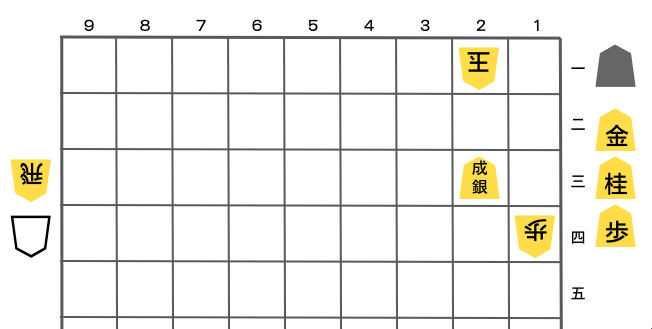
In the situation of picture #3, there is no way for Gote to move and it will be in checkmate either in the following patterns:
• against △R-2b, ▲N-3c will checkmate,
• against △K-3a, ▲G-4a will checkmate,
• and against △K-1a, ▲P-1b and ▲G-2a will checkmate.
If you are in the situation in which you can check, you may feel to check soon. It’s understandable, but in Shogi, the move by which you can prepare for the next good attacking move is more likely to be a good move.
Keep in mind that you should think about what is best for you in the long-term rather than focusing on the short-term. Be careful not to let Gyoku (King) escape by your checking.
“Tag Chasing a King”, introduced in the following article, is good for Shogi beginner children to practice to capture Gyoku (King).
